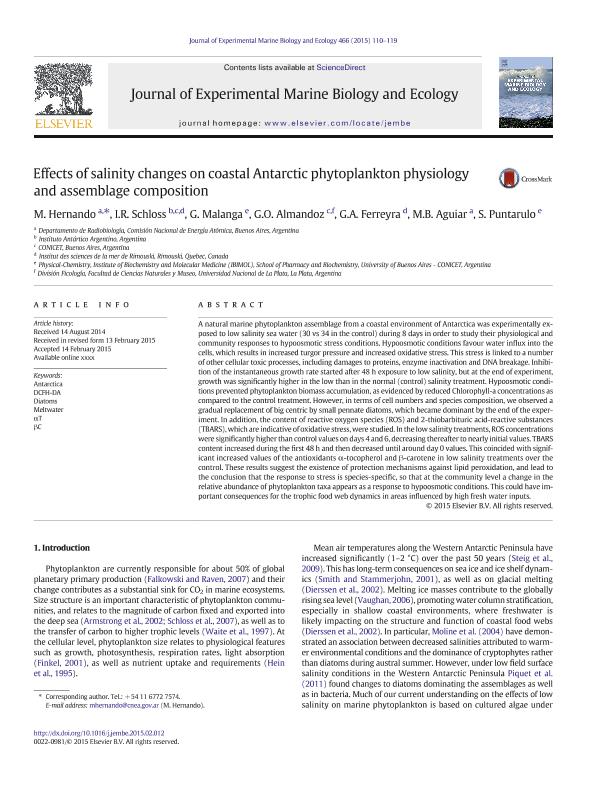Mostrar el registro sencillo del ítem
dc.contributor.author
Hernando, Marcelo Pablo

dc.contributor.author
Schloss, Irene Ruth

dc.contributor.author
Malanga, Gabriela Fabiana

dc.contributor.author
Almandoz, Gaston Osvaldo

dc.contributor.author
Ferreyra, Gustavo Adolfo

dc.contributor.author
Aguiar, María Belén

dc.contributor.author
Puntarulo, Susana Ángela

dc.date.available
2018-03-14T20:37:38Z
dc.date.issued
2015-05
dc.identifier.citation
Hernando, Marcelo Pablo; Schloss, Irene Ruth; Malanga, Gabriela Fabiana; Almandoz, Gaston Osvaldo; Ferreyra, Gustavo Adolfo; et al.; Effects of salinity changes on coastal Antarctic phytoplankton physiology and assemblage composition; Elsevier Science; Journal of Experimental Marine Biology and Ecology; 466; 5-2015; 110-119
dc.identifier.issn
0022-0981
dc.identifier.uri
http://hdl.handle.net/11336/38822
dc.description.abstract
A natural marine phytoplankton assemblage from a coastal environment of Antarctica was experimentally exposed to low salinity sea water (30 vs 34 in the control) during 8. days in order to study their physiological and community responses to hypoosmotic stress conditions. Hypoosmotic conditions favour water influx into the cells, which results in increased turgor pressure and increased oxidative stress. This stress is linked to a number of other cellular toxic processes, including damages to proteins, enzyme inactivation and DNA breakage. Inhibition of the instantaneous growth rate started after 48. h exposure to low salinity, but at the end of experiment, growth was significantly higher in the low than in the normal (control) salinity treatment. Hypoosmotic conditions prevented phytoplankton biomass accumulation, as evidenced by reduced Chlorophyll-a concentrations as compared to the control treatment. However, in terms of cell numbers and species composition, we observed a gradual replacement of big centric by small pennate diatoms, which became dominant by the end of the experiment. In addition, the content of reactive oxygen species (ROS) and 2-thiobarbituric acid-reactive substances (TBARS), which are indicative of oxidative stress, were studied. In the low salinity treatments, ROS concentrations were significantly higher than control values on days 4 and 6, decreasing thereafter to nearly initial values. TBARS content increased during the first 48. h and then decreased until around day 0 values. This coincided with significant increased values of the antioxidants α-tocopherol and β-carotene in low salinity treatments over the control. These results suggest the existence of protection mechanisms against lipid peroxidation, and lead to the conclusion that the response to stress is species-specific, so that at the community level a change in the relative abundance of phytoplankton taxa appears as a response to hypoosmotic conditions. This could have important consequences for the trophic food web dynamics in areas influenced by high fresh water inputs.
dc.format
application/pdf
dc.language.iso
eng
dc.publisher
Elsevier Science

dc.rights
info:eu-repo/semantics/openAccess
dc.rights.uri
https://creativecommons.org/licenses/by-nc-nd/2.5/ar/
dc.subject
Antarctica
dc.subject
Dcfh-Da
dc.subject
Diatoms
dc.subject
Meltwater
dc.subject
Αt
dc.subject
Βc
dc.subject.classification
Otras Ciencias Biológicas

dc.subject.classification
Ciencias Biológicas

dc.subject.classification
CIENCIAS NATURALES Y EXACTAS

dc.title
Effects of salinity changes on coastal Antarctic phytoplankton physiology and assemblage composition
dc.type
info:eu-repo/semantics/article
dc.type
info:ar-repo/semantics/artículo
dc.type
info:eu-repo/semantics/publishedVersion
dc.date.updated
2018-03-13T13:55:41Z
dc.journal.volume
466
dc.journal.pagination
110-119
dc.journal.pais
Países Bajos

dc.journal.ciudad
Amsterdam
dc.description.fil
Fil: Hernando, Marcelo Pablo. Comisión Nacional de Energía Atómica; Argentina
dc.description.fil
Fil: Schloss, Irene Ruth. Ministerio de Relaciones Exteriores, Comercio Interno y Culto. Dirección Nacional del Antártico. Instituto Antártico Argentino; Argentina. Institut Des Sciences de la Mer de Rimouski; Canadá. Consejo Nacional de Investigaciones Científicas y Técnicas; Argentina
dc.description.fil
Fil: Malanga, Gabriela Fabiana. Consejo Nacional de Investigaciones Científicas y Técnicas. Oficina de Coordinación Administrativa Houssay. Instituto de Bioquímica y Medicina Molecular. Universidad de Buenos Aires. Facultad de Farmacia y Bioquímica. Instituto de Bioquímica y Medicina Molecular; Argentina
dc.description.fil
Fil: Almandoz, Gaston Osvaldo. Universidad Nacional de la Plata. Facultad de Ciencias Naturales y Museo. Division Ficología; Argentina. Consejo Nacional de Investigaciones Científicas y Técnicas; Argentina
dc.description.fil
Fil: Ferreyra, Gustavo Adolfo. Institut Des Sciences de la Mer de Rimouski; Canadá. Consejo Nacional de Investigaciones Científicas y Técnicas; Argentina
dc.description.fil
Fil: Aguiar, María Belén. Comisión Nacional de Energía Atómica; Argentina. Consejo Nacional de Investigaciones Científicas y Técnicas; Argentina
dc.description.fil
Fil: Puntarulo, Susana Ángela. Consejo Nacional de Investigaciones Científicas y Técnicas. Oficina de Coordinación Administrativa Houssay. Instituto de Bioquímica y Medicina Molecular. Universidad de Buenos Aires. Facultad de Farmacia y Bioquímica. Instituto de Bioquímica y Medicina Molecular; Argentina
dc.journal.title
Journal of Experimental Marine Biology and Ecology

dc.relation.alternativeid
info:eu-repo/semantics/altIdentifier/doi/http://dx.doi.org/10.1016/j.jembe.2015.02.012
dc.relation.alternativeid
info:eu-repo/semantics/altIdentifier/url/https://www.sciencedirect.com/science/article/pii/S0022098115000428
Archivos asociados
